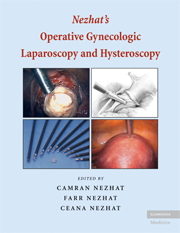Book contents
- Frontmatter
- Contents
- Contributing Authors
- Forewords
- Preface
- 1 HISTORY OF MODERN OPERATIVE LAPAROSCOPY
- 2 EQUIPMENT
- 3 ANESTHESIA
- 4 LAPAROSCOPIC ACCESS
- 5 LAPAROSCOPIC SUTURING
- 6 INTRAPERITONEAL AND RETROPERITONEAL ANATOMY
- 7 FERTILITY
- 8 HYSTEROSCOPY
- 9 MANAGEMENT OF ADNEXAL MASSES
- 10 ENDOMETRIOSIS
- 11 LAPAROSCOPIC ADHESIOLYSIS AND ADHESION PREVENTION
- 12 LEIOMYOMAS
- 13 HYSTERECTOMY
- 14 PELVIC FLOOR
- 15 LAPAROSCOPIC TREATMENT OF CHRONIC PELVIC PAIN
- 16 GYNECOLOGIC MALIGNANCY
- 17 LAPAROSCOPY IN THE PREGNANT PATIENT
- 18 MINIMAL ACCESS PEDIATRIC SURGERY
- 19 LAPAROSCOPIC VASCULAR SURGERY IN 2007
- 20 COMPLICATIONS IN LAPAROSCOPY
- 21 ADDITIONAL PROCEDURES FOR PELVIC SURGEONS
- 22 LAPAROSCOPY SIMULATORS FOR TRAINING BASIC SURGICAL SKILLS, TASKS, AND PROCEDURES
- 23 ROBOT-ASSISTED LAPAROSCOPY
- 24 HYSTEROSCOPY AND ENDOMETRIAL CANCER
- 25 OVERVIEW OF COMPLICATIONS
- Appendix
- Atlas
- Index
18 - MINIMAL ACCESS PEDIATRIC SURGERY
Published online by Cambridge University Press: 23 December 2009
- Frontmatter
- Contents
- Contributing Authors
- Forewords
- Preface
- 1 HISTORY OF MODERN OPERATIVE LAPAROSCOPY
- 2 EQUIPMENT
- 3 ANESTHESIA
- 4 LAPAROSCOPIC ACCESS
- 5 LAPAROSCOPIC SUTURING
- 6 INTRAPERITONEAL AND RETROPERITONEAL ANATOMY
- 7 FERTILITY
- 8 HYSTEROSCOPY
- 9 MANAGEMENT OF ADNEXAL MASSES
- 10 ENDOMETRIOSIS
- 11 LAPAROSCOPIC ADHESIOLYSIS AND ADHESION PREVENTION
- 12 LEIOMYOMAS
- 13 HYSTERECTOMY
- 14 PELVIC FLOOR
- 15 LAPAROSCOPIC TREATMENT OF CHRONIC PELVIC PAIN
- 16 GYNECOLOGIC MALIGNANCY
- 17 LAPAROSCOPY IN THE PREGNANT PATIENT
- 18 MINIMAL ACCESS PEDIATRIC SURGERY
- 19 LAPAROSCOPIC VASCULAR SURGERY IN 2007
- 20 COMPLICATIONS IN LAPAROSCOPY
- 21 ADDITIONAL PROCEDURES FOR PELVIC SURGEONS
- 22 LAPAROSCOPY SIMULATORS FOR TRAINING BASIC SURGICAL SKILLS, TASKS, AND PROCEDURES
- 23 ROBOT-ASSISTED LAPAROSCOPY
- 24 HYSTEROSCOPY AND ENDOMETRIAL CANCER
- 25 OVERVIEW OF COMPLICATIONS
- Appendix
- Atlas
- Index
Summary
The rapid co-evolution of instrumentation and surgical technique has allowed for an ever-growing number of pediatric procedures to be performed using minimal access surgery (MAS). Presently, patients of any size or age (i.e., from fetus to adolescent) can benefit from MAS. This chapter discusses current applications of MAS in infants and children and explores new developments and future directions in the field. Throughout this chapter, the term MAS is defined as procedures that are performed with tiny (≤12-mm) incisions, those performed percutaneously, or those performed endoluminally. It encompasses the field of robotic surgery and image-guided therapy. Common synonyms are laparoscopic surgery (abdominal MAS), thoracoscopic surgery (thoracic MAS), videoscopic surgery, and endosurgery.
WHY MINIMAL ACCESS PEDIATRIC SURGERY?
To date, there is only one randomized controlled trial of MAS in the pediatric population; however, many large retrospective studies in adults have demonstrated decreased postoperative pain, earlier return to feeds, shorter hospital stays, and improved cosmetic results when compared with open surgery. Despite these advantages, a number of concerns limited early widespread adoption of minimal access techniques in children. Appropriately sized instruments were slow to develop as the manufacturers focused on the adult population. The cost of these instruments was believed to be too high and the length of setup too long. Further, perioperative pain and stress have historically been underappreciated in children, and the benefit of smaller incisions was not seen to be substantial as many pediatric surgeons believed they had already made “small incisions.”
- Type
- Chapter
- Information
- Nezhat's Operative Gynecologic Laparoscopy and Hysteroscopy , pp. 509 - 515Publisher: Cambridge University PressPrint publication year: 2008



